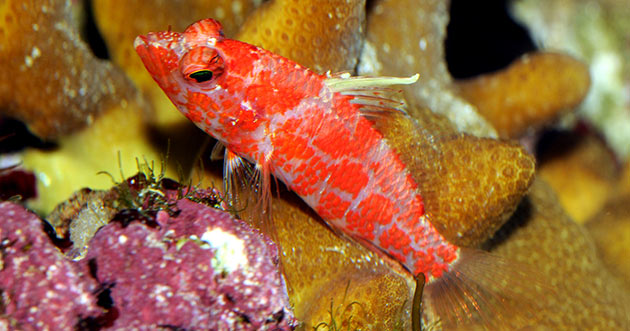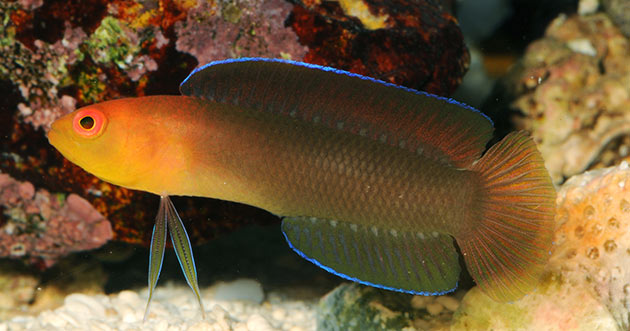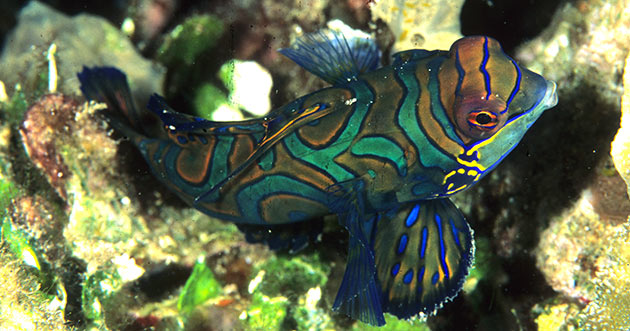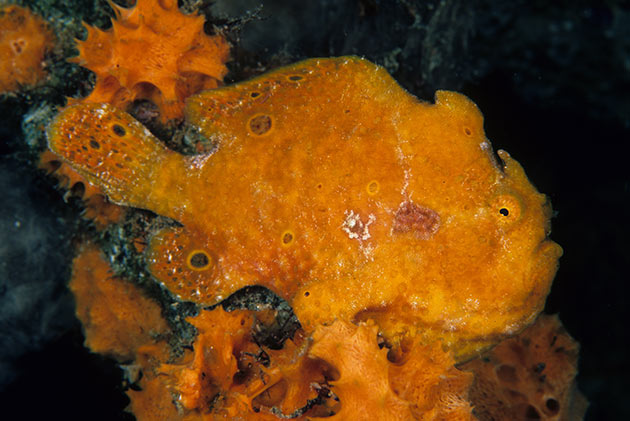Coral-Friendly Fishes: Selecting Fishes for your Reef Aquarium
Part 1: Understanding Food Habits
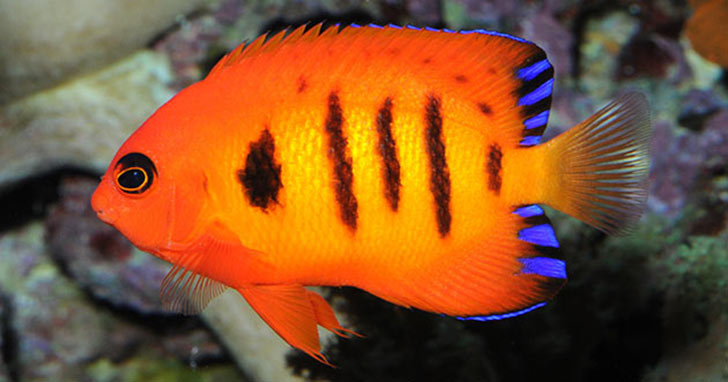
Coral-Friendly Fishes: Selecting Fishes for your Reef Aquarium Part 1: Understanding Food HabitsI cannot think of a captive ecosystem that is as dazzling as a reef aquarium with a healthy complement of coral reef fishes. The lovely hues and interesting shapes of stony and soft corals can be alluring, but these animals are sedentary and exhibit a rather limited repertoire of behavior. In contrast, coral reef fish not only add color and form to the captive reef, they also provide “personality.” A shoal of colorful Anthias over aquarium décor, a Blenny peeking out from a hole in the live rock, or a Shrimpgoby watching after its industrious crustacean companion make the reef aquarium that much more mesmerizing. While there are hundreds of fishes suitable for the coral aquarium, there are also species that are not “cnidarian-friendly.” Therefore, it is important for the coral-keeper to do some homework before he or she goes out fish-shopping. Understanding food habits of marine fishes is the first step in making wise choices when putting together your reef aquarium fish community.
Understanding Food Habits of Marine Fishes
I assume that you would agree that a fish whose diet includes the corals you are attempting to keep is not going to be welcome in your aquarium! So, the first thing we need to do is investigate the food habits of the species in question. But how do we do this? The LiveAquaria website (as well as a good marine aquarium fish guide) provides some of this information under each species account. If you want to dig a little deeper, you can track down food habit studies published in scientific literature. While there was a time when you would have to go to university libraries to find papers on reef fish food habits, now many are available on the web. (Simply use the terms “food habits” and “reef fishes” when doing a search in Google Scholar.) Another place to find this information is in some of the more information-rich guide books on coral reef fishes. If a food habit study indicates that a fish eats coral in the wild, it is going to be more likely to do so in captivity. However, this is not always the case (more on this below).
Dietary studies conducted in the wild indicate the fishes most likely to prey on scleractinians include: Butterflyfishes (many in the genus Chaetodon and Heniochus), several Damselfishes (e.g., Cheiloprion labiatus, Plectroglyphidodon dickii, P. johnstonianus), a handful of Wrasses (namely members of the genera Labropsis, Labrichthys and Larabicus), a few Blennies (most noteworthy is Exallias brevis), some Parrotfishes (e.g., Cetoscarus bicolor), certain Triggerfishes (e.g., Balistapus, Balistoides, Pseudobalistes and Rhinecanthus), a number of Filefishes (e.g., Amanses, Cantherhines, Oxymonacanthus and Pervagor) and some Puffers (e.g., Arothron and Canthigaster). While these are the best known corallivores, there are many other species of reef fishes that will occasionally nip on a stony coral polyp. How about soft corals? The groups that most often feed on these cnidarians include: some larger Angelfishes (especially Holacanthus and Pomacanthus spp. from the Atlantic), Batfishes, Boxfishes, certain Triggerfishes, some Filefishes and a number of Puffers. The most notable soft coral predators are members of the Butterflyfish family (the Blackback Butterflyfish ((Chaetodon melannotus)) and Tailspot Butterfly ((C. ocellicaudus)) specialize in feeding on soft corals).
Will the Fish Eat Corals in My Reef Aquarium?
Predicting what a fish will eat in captivity is not always as easy as looking at the diet of a wild population. In nature, the diet of a fish can be impacted by prey abundance, which can vary from one location to the next, as well as from one year to the next. For example, in Panama, the Guineafowl Puffer (Arothron meleagris) feeds heavily on stony corals when they are available. But during years when corals were killed by warm water temperatures caused by El Nino, these Puffers changed their “search image” and began feeding on sponges, tunicates and coralline algae. If we were to look at a short-term food habit study done on A. meleagris from Panama during those years when corals were not readily available, you might come to the erroneous conclusion that corals are not important in this species diet and that you might get away with keeping it with corals. But keeping this, or any Arothron spp. for that matter, in your reef aquarium would be a very bad idea!
Another thing to consider is that a fish’s dietary predilections in the aquarium can be affected by the conditions it is kept in. For example, if you do not a feed grazing fish (e.g., Surgeonfishes, Rabbitfishes) often enough, it may start investigating other potential food sources, which may include coral polyps. This behavior is often exasperated by the fact that some reef aquarists are reluctant to feed their fish frequently. Also, an older aquarium resident that is not bothering invertebrates, and may not naturally feed on corals, may develop a “taste” for a cnidarian neighbor after watching a newly introduced fish begin picking at a coral. This is known as social facilitation. There are also those episodes when a species that is usually not a threat to cnidarians, begins picking at corals for no apparent reason. While food habit studies conducted on wild populations are a good place to start our search for coral-friendly fishes, they certainly do not guarantee a piscine species equipped with the proper dentition will not start eating your corals. Those species that don’t or rarely feed on stony coral in the wild, but are potential coral-pickers in the aquarium, include all of the Angelfishes (even the Genicanthus which normally feed on zooplankton), many of the algae or detritus-eating Blennies (e.g., Ecsenius, Istiblennius), all of the Surgeonfishes (including the normally innocuous Palette or Blue Tang ((Paracanthurus hepatus)), Moorish Idols and most Rabbitfishes.
Conversely, there are some fish species that have a corallivorous “rap-sheet” when it comes to their wild diets that can be kept in reef aquariums without damaging cohabiting corals. For example, there are a several species in the genus Canthigaster (a.k.a. Tobies or Sharpnosed Puffers) that have been housed with stony and soft corals without incident. Many members of this genus include stony coral polyps in their natural diets. There are also a number of Filefishes and Boxfishes, which may include some corals in their “wild” diets, that have been kept in reef aquariums without eating coral neighbors. There are even Butterflyfishes that can be housed in reef aquariums. Chaetodontids that are soft coral predators can sometimes be housed with small-polyped stony corals, while some scleractinian-eating Butterflies are well-mannered in a system that contains certain soft corals. And then there are those Butterflyfishes that do not feed on corals at all in the wild that typically ignore them in the aquarium. All of that said, keeping any species in a reef aquarium that naturally includes any corals in its diet, even if corals do not form a large portion of the species natural bill of fare, is a calculated risk that you better consider carefully before you plop this fish into your aquarium. Experienced reef-keepers will tell you that are new to the hobby that it may take dismantling the aquarium décor to remove a misbehaving fish once it is introduced to the aquarium habitat.
Coral-Friendly Fishes - Safe Bets
Generally speaking, the fishes that are the least dangerous to corals are those that do not have the jaws and teeth suitable for grazing on algae or sessile invertebrates. This group is comprised mainly of zooplanktivores, microcarnivores that feed on tiny crustaceans, or carnivores that suck-up larger prey items (e.g., fish-eaters). Families represented in these feeding guilds include: Garden Eels, Coral Catfishes, Lizardfishes, Seahorses and Pipefishes, Frogfishes, Squirrelfishes, Scorpionfishes, Waspfishes, Groupers, Grammas, Dottybacks, Comets and Assessors, Cardinalfishes, Tilefishes, Hawkfishes, Jawfishes, Dragonets, Gobies, Dartfishes and Sandperches. There are many species of Wrasse (including Fairy and Flasher Wrasses) and some zooplankton-feeding Damsels that are also not anatomically equipped to feed on corals. Understanding Food Habits of Marine Fishes
How do you know when a coral is being assaulted by one of your fish? There are several things you can do to dissuade fish from nipping at your corals. More frequent feeding can provide some relief for your corals. Fish that are not getting enough to eat are more likely to start picking at coral polyps and clam mantles. Herbivores are also less of a threat if they have enough algae in the aquarium to feed on. If they have succeeded in cropping most of the algae in your system, add freeze-dried sheets of algae, pieces of frozen or steamed romaine lettuce, broccoli florets, or dandelion stems every day.
 Scott Michael Scott W. Michael is an internationally-recognized writer, underwater photographer, and marine biology researcher specializing in reef fishes, and was the Banquet Speaker at our 2007 and 2008 Coral Conference and Frag Swap. He is a regular contributor to Aquarium Fish Magazine, Freshwater and Marine Aquarium Magazine, SeaScope, and is the author of Reef Fishes Vol 1, Vol 2, and Vol 3, Vol 4, and Vol 5., A Pocket Expert Guide Marine Fishes, A Pocket Expert Guide to Reef Aquarium Fishes, 101 Best Saltwater Fishes: How to Choose and Keep Hardy, Brilliant, Fascinating Species That Will Thrive in Your Home Aquarium, Reef Sharks & Rays of the World, and Aquarium Sharks & Rays. Having studied marine biology at the University of Nebraska, Scott has served as a scientific consultant for National Geographic Explorer, the Discovery Channel, and French educational television. References: Fishelson, L. 1975. Observations on behavior of the fish Meiacanthus nigrolineatus Smith-Vaniz (Blenniidae) in Nature (Red Sea) and in Captivity. Aust. J. Mar. Freshwater Res. 26(3): 329-341. Losey, G.S. Jr. 1975. Meiacanthus atrodorsalis: field evidence of predation protection. Copeia. 1975(3): 574-576. Moorhead, J.A. and Zeng, C., 2011. Breeding of the forktail blenny Meiacanthus atrodorsalis: broodstock management and larval rearing. Aquaculture, 318(1), pp.248-252. Russell, B.C., Allen, G.R., and H.R. Lubbock. 1976. New cases of mimicry in marine fishes. J. Zool. Lond. 180(3): 407-423. |
|||||||||
|
|




